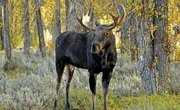Elk are the second largest of the deer in North America. They are magnificent animals to observe in the wild and prized hunting targets. Learning how to identify and track elk increases the likelihood of viewing one or bringing home a trophy. Read on to learn more.
Measure the track to identify elk. Elk tracks are generally four inches or longer. Smaller tracks likely belong to deer. In contrast, moose tracks are longer than 5 inches.
Identify elk by the shape of the track's edges. Elk tracks are more rounded than moose or deer tracks. Imagine a line drawn along the inside of the track. Elk tracks have empty space between the track and the imaginary line.
Rule out the possibility the tracks were made by cattle. This is only a concern if you know that there are domesticated cattle nearby. Cattle tracks have a more circular appearance than elk tracks. The widest point of a cattle track is near the center, while the widest point for an elk track is lower.
Check the spacing of the toes. If the toes are closer at the back than at the tip, the track is probably elk. Deer, moose and cattle have evenly spaced toes.
Tips
- If the elk was running its hooves will be splayed. A splayed track is obvious because the toes are angled out which leaves more space between them.
- These steps identify tracks belonging to the American elk, Cervus canadensis. In Europe moose are also called elk, but they are a different species.
Tips
- If the elk was running its hooves will be splayed. A splayed track is obvious because the toes are angled out which leaves more space between them.
- These steps identify tracks belonging to the American elk, Cervus canadensis. In Europe moose are also called elk, but they are a different species.
Writer Bio
This article was written by the CareerTrend team, copy edited and fact checked through a multi-point auditing system, in efforts to ensure our readers only receive the best information. To submit your questions or ideas, or to simply learn more about CareerTrend, contact us [here](http://careertrend.com/about-us).


